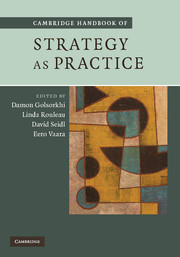Book contents
- Frontmatter
- Contents
- List of figures
- List of tables
- List of contributors
- Introduction: What is Strategy as Practice?
- PART I ONTOLOGICAL AND EPISTEMOLOGICAL QUESTIONS
- PART II THEORETICAL DIRECTIONS
- PART III METHODOLOGICAL TRACKS
- PART IV APPLICATION VARIATIONS
- 18 Institutional change and strategic agency: an empirical analysis of managers' experimentation with routines in strategic decision-making
- 19 Unpacking the effectivity paradox of strategy workshops: do strategy workshops produce strategic change?
- 20 Struggling over subjectivity: a critical discourse analysis of strategic development
- 21 Strategizing and history
- Author Index
- Index
- References
18 - Institutional change and strategic agency: an empirical analysis of managers' experimentation with routines in strategic decision-making
Published online by Cambridge University Press: 05 October 2012
- Frontmatter
- Contents
- List of figures
- List of tables
- List of contributors
- Introduction: What is Strategy as Practice?
- PART I ONTOLOGICAL AND EPISTEMOLOGICAL QUESTIONS
- PART II THEORETICAL DIRECTIONS
- PART III METHODOLOGICAL TRACKS
- PART IV APPLICATION VARIATIONS
- 18 Institutional change and strategic agency: an empirical analysis of managers' experimentation with routines in strategic decision-making
- 19 Unpacking the effectivity paradox of strategy workshops: do strategy workshops produce strategic change?
- 20 Struggling over subjectivity: a critical discourse analysis of strategic development
- 21 Strategizing and history
- Author Index
- Index
- References
Summary
This chapter is dedicated to the memory of Stuart Smith who died in 2007.
Introduction
One of the key issues in Strategy as Practice research is the relationship between institutionalized practice and the activities of strategists as institutional actors (Johnson et al. 2007; Whittington in this handbook). There is also increasing interest by institutional theorists in how institutional actors engage with and contribute to processes of institutional change – work which is reviewed in what follows. This chapter therefore brings together a concern raised by the Strategy as Practice perspective with those interested in the micro-foundations of institutional forms. The specific focus is the extent to which institutionalized routines persist and to what extent and how they are changed by strategic actors' experimentation with such routines throughout a period of major institutional change.The chapter does this by first briefly reviewing the literature on the role actors play in institutional change and, in particular, their engagement and experimentation with institutionalized routines. There follows an explanation of the ethnographic nature of the methodology employed in the research. The findings of the research are then presented in terms of an analytic account of how strategic actors influence changes in routines within a series of episodes and sub-episodes that were part of the institutional changes resulting from the privatization of British Rail (BR) in the 1990s. The chapter concludes with a discussion of the theoretical insights arising from this analysis that helps explain how what strategic actors do affects institutional forms.
- Type
- Chapter
- Information
- Cambridge Handbook of Strategy as Practice , pp. 273 - 290Publisher: Cambridge University PressPrint publication year: 2010
References
- 5
- Cited by



